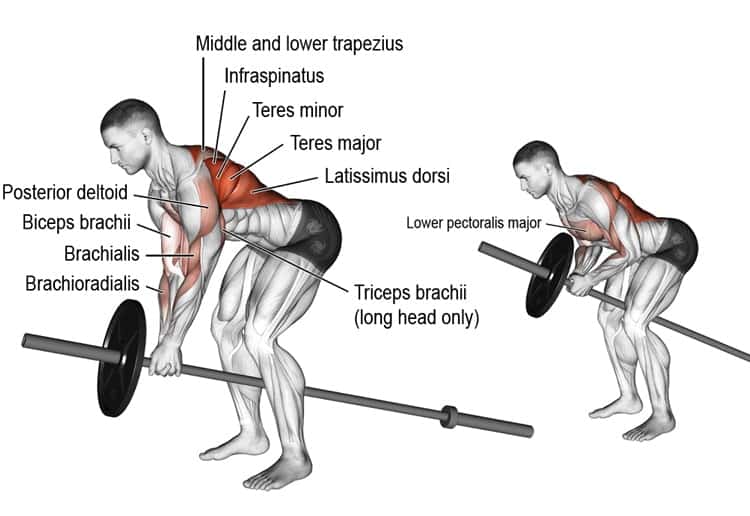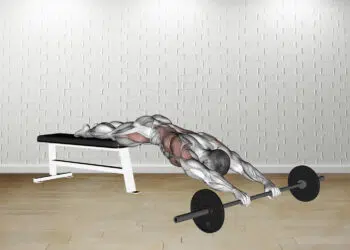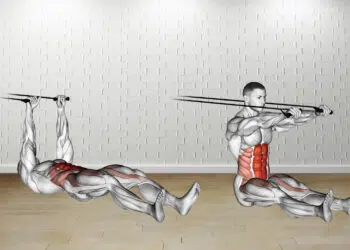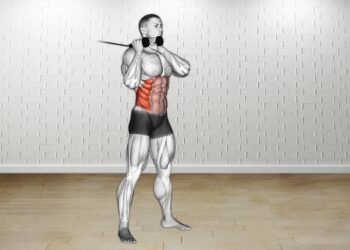The landmine row, a timeless and old school exercise, is essential for achieving unparalleled back strength and growth. As a versatile compound movement, it not only allows for significant weight loading to stimulate the entire upper posterior chain but also offers various techniques, from using a v-bar to one-arm variations. While experimenting with these variations can be fruitful, beginners are advised to start with both hands to ensure proper form and safe progression. Incorporating the landmine row into your back routine is non-negotiable for those seeking optimal results.
Understanding the Landmine Row
Your back isn’t just a display of power; it’s the foundation of many functional movements. As the second largest trainable muscle group, following closely behind the legs, your back craves variety to reach its fullest potential. Rows, and in particular, the landmine row, are unparalleled in delivering that thickness and depth.
A minimalist’s dream, the landmine row can be executed in the most basic gym setups. All you need is a barbell. The anchored nature of this workout ensures a deep mind-muscle connection, promoting maximum contraction and muscle fiber engagement.
The Back’s Role and the Value of Rows
Your back, vast and powerful, is second only to your legs in sheer muscle mass. Achieving an even development across this massive canvas requires a diverse set of exercises, with rows standing out. The Landmine Row, in particular, is versatile enough for even the most basic gym setups, demanding only a barbell. With a properly anchored barbell, it enables a keen mind-muscle connection, ensuring optimal contraction during the exercise.
Setting Up the Landmine Row
The Landmine Row, despite its rather aggressive name, is all about refining a powerful rowing technique. Here’s a basic setup:
- Anchor one end of the barbell using a weight plate.
- Stabilize it either against a wall junction or within a squat rack.
- You can also use equipment like a landmine attachment.
- Alternatively, have a partner hold one end while you row from the other.
Targeted Muscles

This compound exercise calls several muscles into action:
Level Up Your Fitness: Join our 💪 strong community in Fitness Volt Newsletter. Get daily inspiration, expert-backed workouts, nutrition tips, the latest in strength sports, and the support you need to reach your goals. Subscribe for free!
- Rhomboids
- Teres Major and Minor
- Erector Spinae
- Posterior Deltoid
- Trapezius
- Infraspinatus
- Latissimus Dorsi
- Brachialis
- Brachioradialis
- Biceps Brachii
- Lower Pectoralis Major
Why Choose the Landmine Row?
Range of Motion
The anchored barbell end creates a unique lifting angle, merging both vertical and horizontal forces. This allows for an organic, controlled movement, potentially enhancing muscle contractions.
Shift in Resistance
Every exercise offers a distinct resistance curve. The Landmine Row provides fluctuating resistance – starting horizontal against gravity, then lightening as you lift in an arc.
Perfect for Beginners
The Landmine Row’s predictable arc is a boon for newcomers, ensuring that they can maintain form. Plus, it also helps in strengthening shoulder stabilizers, often tricky for newbies.
Balance and Stability
This row can easily morph into a unilateral exercise, ideal for rectifying muscle imbalances and honing overall balance.
Lowered Injury Risk
For those with back concerns, the Landmine Row is a safer alternative. Its flexibility allows individuals to adjust movements, lessening spinal and shoulder strain compared to traditional rows.
Getting the Technique Right
Perfecting the Landmine Row:
- Secure one barbell end.
- Load the free end with the chosen weight.
- Stand with feet on either side of the barbell.
- Hold the barbell with both hands, upper body angled slightly forward.
- Keep a slight bend in the knees and a straight back.
- Engage your core, pull the barbell towards the chest leading with your elbows.
- Retract your shoulder blades at the top.
- Pause, then return to the start.
Watch how to do the landmine row:
Variations & Tips:
- You can use a V-bar rather than just gripping the barbell by itself. Or, you can train one arm at a time for unilateral development.
- Start light and develop good form before progressing to a heavier weight for muscle and strength-building benefits.
- The landmine row is a very effective upper posterior chain exercise as it works all of the back muscles.
Avoiding Common Mistakes
The Landmine Row is effective, but not immune to errors:
- Too Much Bend: Excessive bending can compromise form and potentially harm your lower back.
- Misaligned Stance: Feet should remain consistent, about shoulder-width apart.
- Forgetting the Core: Keep the core engaged throughout to avoid losing balance.
- Overloading: Excessive weight can lead to injury and poor form.
Variations of the Landmine Row
Delving into variations can refresh your routine and prevent it from becoming monotonous. Each variation targets specific muscles slightly differently, ensuring a well-rounded approach to your back development.
1. One-Arm Landmine Row
Target: Primarily the lats and the middle back.
This unilateral exercise offers a focused approach, targeting each side of the back separately. It helps in identifying and rectifying muscle imbalances.
Effectiveness: Engaging primarily the lats and middle back, the one-arm technique allows for a greater range of motion and isolation, emphasizing each lat individually.
How to Do It:
- Stand perpendicular to the barbell.
- Grip the free end with one hand.
- With the opposite leg forward in a staggered stance, lean over slightly.
- Row the barbell towards your hip, keeping your elbow close to your body.
- Ensure the core remains engaged throughout the movement.
2. High Row Variation
Target: Focuses more on the upper traps, rear deltoids, and rhomboids.
By altering the row’s angle, this variation emphasizes the upper back region. It’s excellent for posture improvement and shoulder stability.
Level Up Your Fitness: Join our 💪 strong community in Fitness Volt Newsletter. Get daily inspiration, expert-backed workouts, nutrition tips, the latest in strength sports, and the support you need to reach your goals. Subscribe for free!
Effectiveness: It targets the upper traps, rear deltoids, and rhomboids more intensely, helping sculpt the upper back and rear shoulder region.
How to Do It:
- Stand facing the barbell’s free end.
- Grip the barbell with both hands.
- Pull the barbell towards your upper chest or collarbone area.
- As you pull, your elbows should flare out to the sides.
3. Meadows Row
Target: Aims at isolating the lats, named after the bodybuilder John Meadows.
Named after bodybuilder John Meadows, this variation prioritizes lat isolation, making it an excellent tool for lat development.
Effectiveness: The single hand grip and specific stance put more focus on the lats, ensuring a deeper muscle engagement.
How to Do It:
- Stand perpendicular to the barbell.
- Use a single hand grip (with a handle if available) on the free end.
- With feet shoulder-width apart, slightly bend your knees and lean forward.
- Row the barbell towards your hip, allowing the elbow to move past the body.
4. Wide-Grip Landmine Row
Target: Engages the teres major, rear deltoids, and a different portion of the lats.
With the inclusion of a wider grip, this variation disperses the tension across a broader area of the back.
Effectiveness: By engaging the teres major, rear deltoids, and a different portion of the lats, it ensures a more comprehensive back workout.
How to Do It:
- Stand facing the barbell’s free end.
- Use a wide grip or even a T-bar handle if available.
- Pull the barbell towards the chest, ensuring your elbows are flaring out wide.
5. Landmine Twist Row
Target: Incorporates obliques and serratus anterior along with traditional back muscles.
Incorporating a twisting motion, this variation adds a core workout to the traditional back row, offering a compound exercise benefit.
Effectiveness: Alongside traditional back muscles, the added twist engages obliques and serratus anterior, enhancing core strength and stability.
How to Do It:
- Stand facing the barbell’s free end.
- Grip the barbell with both hands and start with a traditional row movement.
- As you lift, add a twist to one side and then return to the center before lowering.
- Alternate sides with each repetition.
6. Half-Kneeling Landmine Row
Target: Targets lower lats and stabilizes core engagement.
The half-kneeling stance stabilizes the lower body, ensuring an isolated upper body workout. It also assists in core engagement and stability.
Effectiveness: Primarily targeting the lower lats, this position minimizes momentum and cheating, leading to a more honest and direct muscle engagement.
How to Do It:
- Position yourself in a half-kneeling stance perpendicular to the barbell.
- With the knee that’s up corresponding to the rowing arm, grip the barbell’s free end.
- Row the barbell, keeping the motion controlled and core engaged.
Conclusion
Each variation of the Landmine Row brings its unique approach and set of benefits. Incorporating these into your routine can offer diversified stimulation to your back muscles, ensuring balanced development and preventing plateauing. As with all exercises, maintaining proper form is crucial for safety and efficacy.
Interested in measuring your progress? Check out our strength standards for Meadows Row, Squat.








